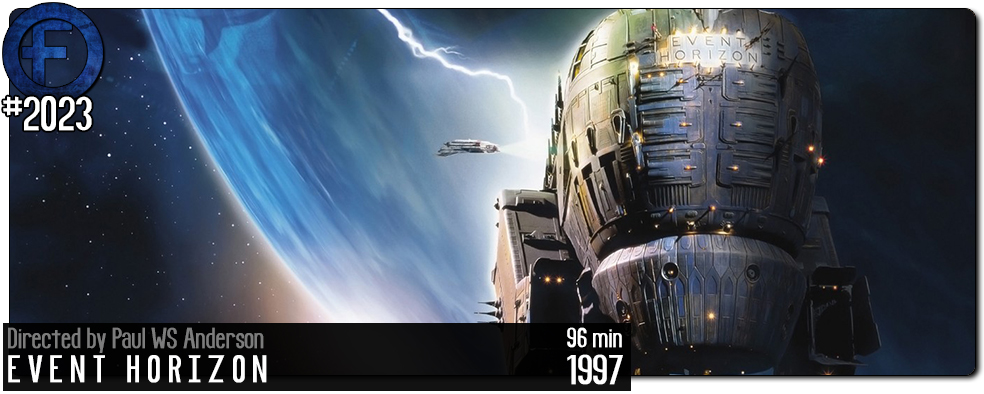Movie Review – Event Horizon
Principal Cast : Lawrence Fishburne, Sam Neill, Kathleen Quinlan, Joely Richardson, Richard T Jones, Jack Noseworthy, Jason Isaacs, Sean Pertwee, Holley Chant, Barclay Wright, Noah Huntley.
Synopsis: A rescue crew investigates a spaceship that disappeared into a black hole and has now returned…with someone or something new on-board.
********
Described by critics of the day as “The Shining in space”, Paul WS Anderson’s gory 1997 outer space horror flick Event Horizon has been reclaimed by subgenre devotees as a minor classic in its own right. Going so far as to outright plagiarise Stephen King’s classic hotel horror, Anderson also lifts from the likes of James Cameron’s Aliens, John Carpenter’s In The Mouth Of Madness (coincidentally also starring Sam Neill) and even 2001: A Space Odyssey; there’s nary an original bone in Event Horizon’s body, but Anderson cannily plays it large and loud and strikes an intriguing tone that, whilst nominally effective for the persistent jump-scares, runs into shallow water by the time the explosive climax arrives to satisfy audiences shocked into submission. Filled with some remarkably evocative imagery and ideas, the film’s indelible gore and “is this, or isn’t this, reality” verve make for compelling, if entirely unsubtle viewing.
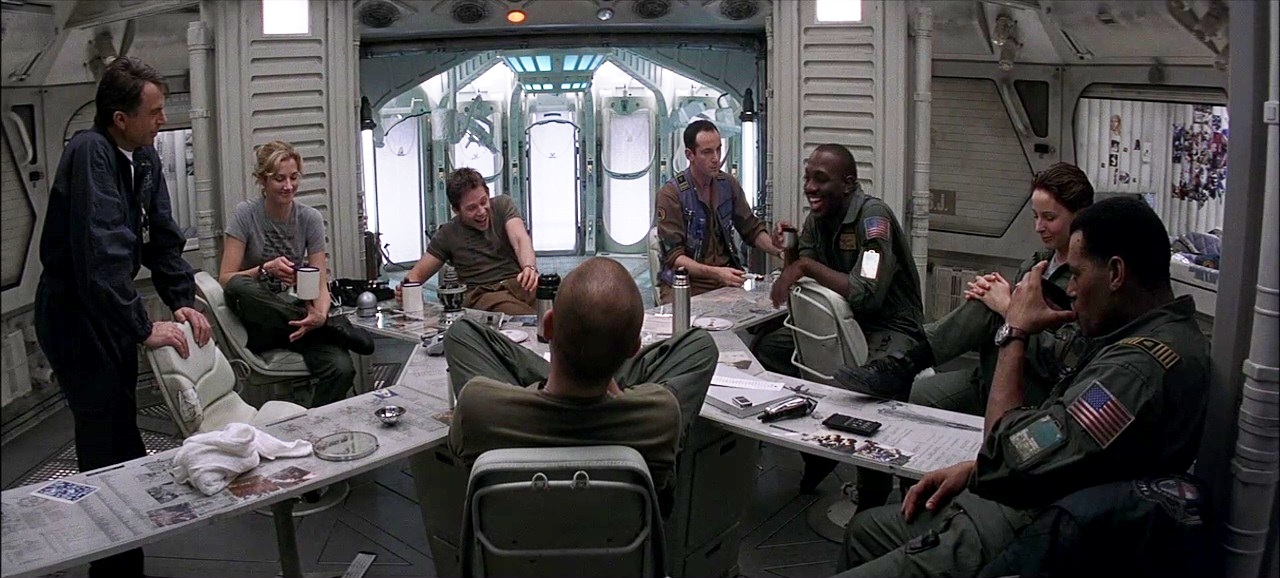
In the year 2040, mankind sent a deep space vessel, the Event Horizon, to explore the outer limits of our solar system, using a device known as a “gravity drive”. It vanished without a trace. Years later, Earth has picked up a signal from the stricken ship, and send a rescue operation to salvage the remains. Aboard the Lewis & Clark, the crew make ready to extract any data, rescue any crew, and salvage any working parts, to return to Earth. Captain Miller (Lawrence Fishburne), medical technician Peters (Kathleen Quinlan), communications officer Starck (Joely Richardson), ensign Justin (Jack Noseworthy), medic DJ (Jason Isaacs) and rescue technician Cooper (Richard T Jones) are accompanied by the Event Horizon’s creator and resident expert Dr William Weir (Sam Neill): they find a vessel empty of life, yet filled with terror. Discovering horrifying ships logs conveying the fate of the ship’s original crew, Miller and his team come to learn that while the Event Horizon was out exploring the darkest corners of the universe, it unknowingly brought something back.

A solid mix of familiarity and ingenuity form the crux of why Event Horizon has endured as a film for so long. It’s exceedingly rare that a sci-fi horror film has leaned so heavily into its horror aspects, with quite a significant level of body-horror gore-porn sprinkled throughout the skin-prickling dread of psychological torment present in Philip Eisner’s diabolical screenplay. Surprisingly, Anderson managed to sneak a lot of the intercut torture and “Hell” imagery present in the film past the studio heads because production was so tight up against the release date, second and third unit were still filming as the movie was being scored. When Paramount eventually did get to see the film, they requested that a lot of the more gruesome footage be excised in order to have the film actually released, lest the ratings classification prevent it from occurring. Whereas a lot of the aforementioned sci-fi classics Event Horizon is derived from – Alien, Aliens, 2001 and the like – work well as cerebral horror films playing with your mind without overt gore too much, Event Horizon went full-throttle into blood-soaked adult terror, ending up as a kind of ghost story mixed with aliens mixed with a trans-dimensional hellscape wrapped up in gloriously unsettling body torture, something Anderson would tap into later with his Resident Evil film franchise.
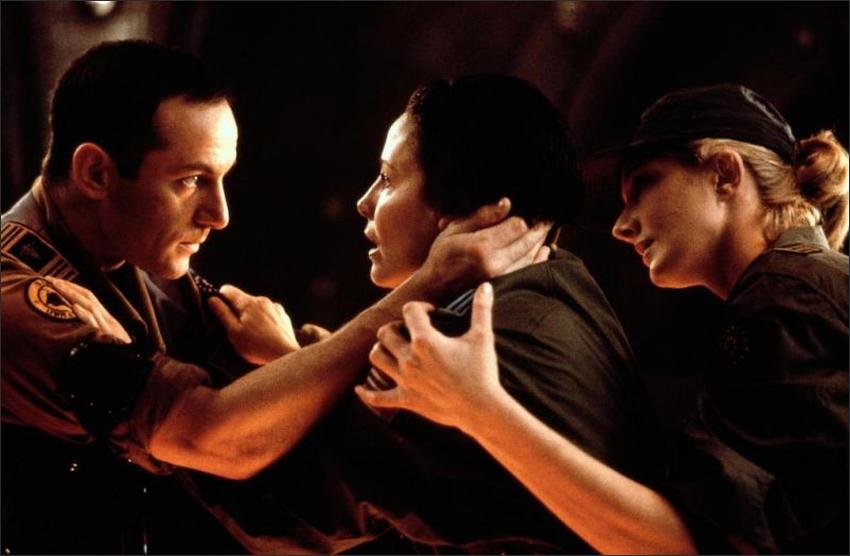
The film plays out in three distinct parts. The first act feels like a direct lift from Aliens, with Sam Neill’s Dr Weir (a proxy for Sigourney Weaver’s Ellen Ripley) waking aboard an orbiting space station and having a number of disconcerting nightmares (or visions?) about his dead wife Claire (played by Holley Chant). The film sets up the near-future militaristic exploratory nature of space travel, and introduces the disparate team members who will form this septet of space seeking success, each a varying personality on the tried-and-true tropes the genre predictably depicts. After we leave near Earth orbit, we fast forward a couple of months to find the Event Horizon in high altitude orbiting Neptune, and it’s here that the film takes on the feel of Ridley Scott’s Alien, in which the exploration of the stricken vessel takes on a similar feel to the Nostromo crew exploring the alien craft on LV426. Quietly dark, empty med-bays and living quarters, a bridge with blood smeared across the walls and consoles, and a disquieting emptiness threaten to overwhelm the rescue crew, before the film shifts into its third, and in my opinion most effective phase, the Everything Goes Batshit Crazy part.

And I do mean crazy. There are some utterly off-the-wall moments in Event Horizon’s lengthy final act, in which the strange minor occurrences start to manifest as outright sentient evil pervading the Event Horizon’s ugly architecture and dense, shadowy design. For an exploration craft, the Event Horizon is built like a Gothic cathedral, with incredibly unsafe structures and sharp surfaces in every corner, not to mention the hugely stylish gravity drive room itself, a spherical horror show that’s a mix of brutalism and nihilism given form, a personification of one of the Bible’s Circles of Hell writ large, if you will. The film’s carefully developed opening sequences, exposition upon which the mystery deepens, give way to a shock-and-awe climax as redundantly loud and jumpy as you will find in a modern feature, yet filled with imagery that, for horror fans such as myself, elicit the requisite unease required to make the film’s opaque final scenes work well. It’s easy to bemoan that the jump-scares and gotcha moments that have become horror staples tend to be overused in modern filmmaking – and they’re overused in this film a lot – but I think the cast, all of whom are exceptionally watchable in this, hold the insanity together just when it all threatens to fall apart.
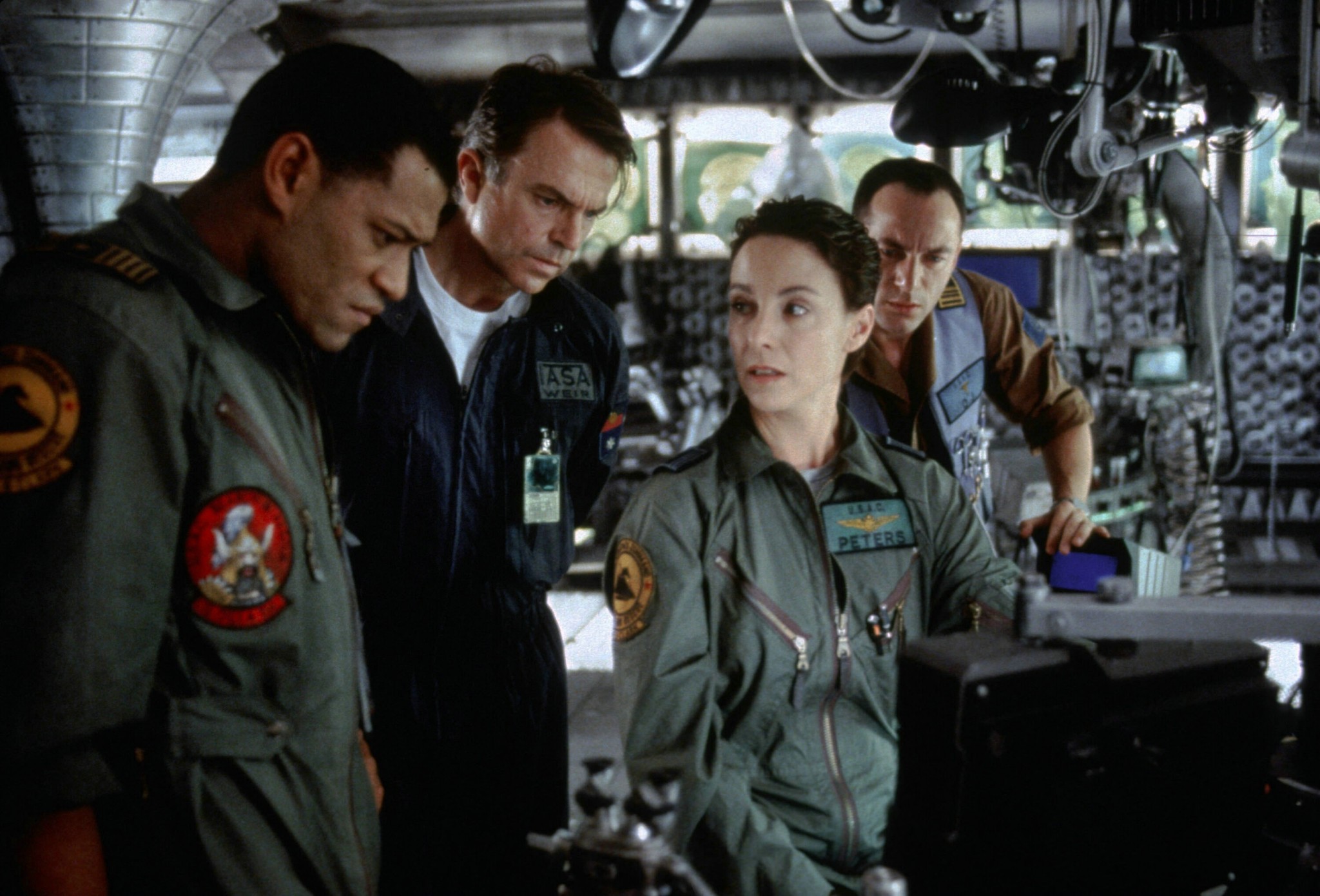
Captain Miller – a proxy for Tom Skerritt’s Captain Dallas in Alien – is the calm and measured commander of his crew, and a calm and measured Lawrence Fishburne gives the part the gravitas it warrants. The reserved Kathleen Quinlan plays a maternally fractured Peters, the medical officer whose disabled son remains with her estranged husband back on Earth. Richard T Jones plays the super-cool, promiscuous and narcissistic Cooper, the gung-ho member of the outfit who womanizes and flirts with the female officers, particularly Joely Richardson’s youthful Starck, as often as he is able. Jason Isaacs and Sean Pertwee give their respective characters interesting nuances and subtleties, whilst the criminally underused Jack Noseworthy (also notable for a moving turn in submarine thriller U571) plays the enthusiastic ensign who becomes the first of the Lewis & Clark crew to fall victim to the Event Horizon’s horrors. Leading the film’s kook is New Zealand actor Sam Neill, who with his softly spoken manner and diffident facial expressions you might think would be out of his wheelhouse in a straight-up horror flick like this, but as Weir he more than holds his own. He is the caterpillar chrysalis turning into the grotesquely deformed butterfly of Event Horizon’s milieu, the pivot on which much of the later stage confusion and insanity sits. As Weir gets close to the Event Horizon, his nightmares become more consequential, and inevitably he is lured to the ship’s dark side, given his paternal attachment to the vessel. At first his role is largely sympathetic, and it’s these contemplative moments in which Neill’s performance is at its best. Once he becomes the dimensional link to the Dark Place, however, Neill’s full form is realised as he dons a pretty decent makeup prosthetic to look more like Pinhead’s distant cousin than a human being.
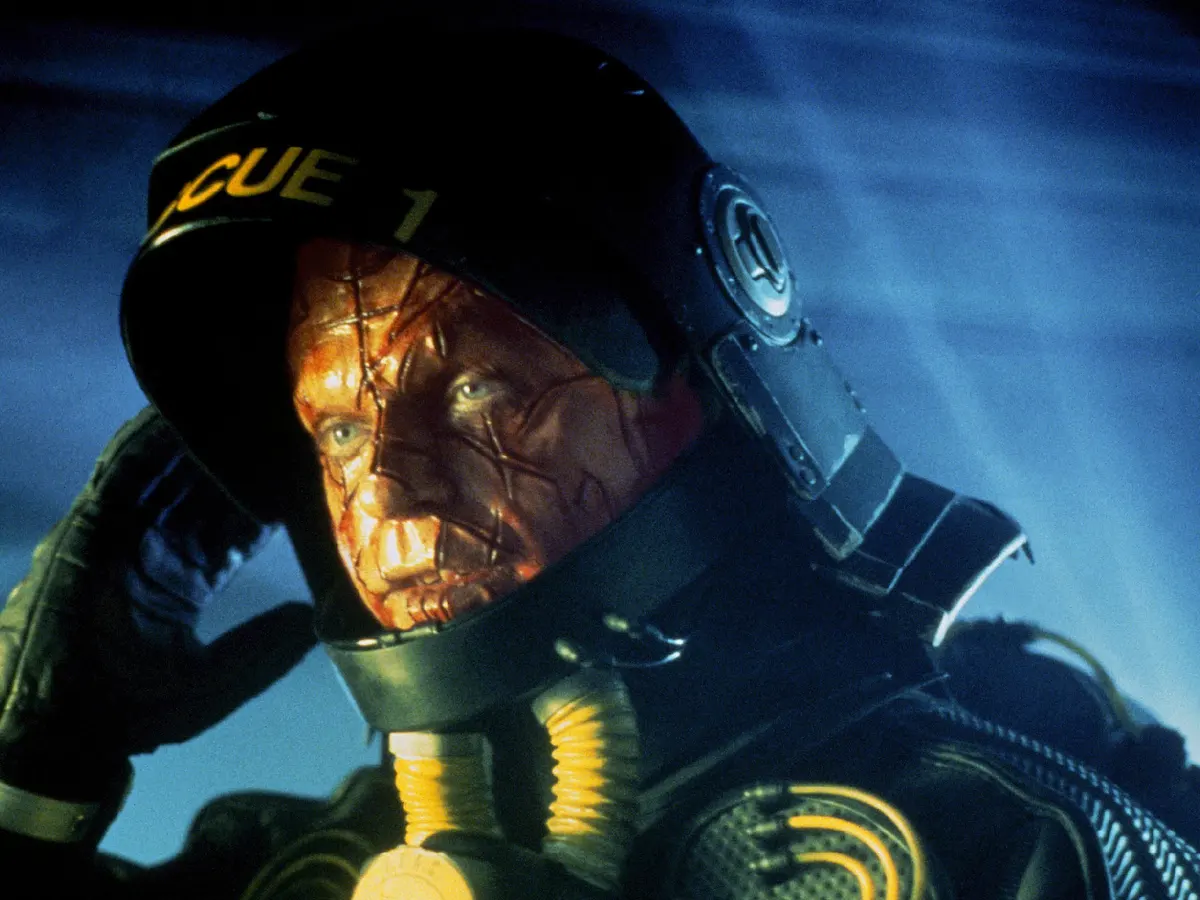
Event Horizon is blessed with a surfeit of production wizardry. I’ve mentioned the design of the Event Horizon itself and the gravity drive, but the entire film has some remarkably detailed and atmospheric set design, from the cramped confines of the Lewis & Clark to the temple-like central passageway of the titular vessel, to its med bay and bridge, and even re-watching it now the film holds up surprisingly well in this regard. Less so conspicuously blessed are the visual effects, some of which are still terrific and some of which are badly, horribly dated. The model work on the exterior spacecraft, and most of the matte work integrating them into CG or green screen environments, is exemplary in all but a few minor moments, with one such great moment coming early with a vertiginous drawback shot of Weir in the orbital station above Earth rolling and rolling and rolling that – even on a relatively smaller screen at home – made my stomach flip a few times. Unfortunately, CG animators in the mid-90’s were still perfecting the art of photoreal CG liquid, and it’s this crucial element in Event Horizon that is by far the most dated effect of all. None of the CG liquid, either floating in zero-G environments nor extruding from the center of the gravity drive early in the story, are rendered well, and are obviously comped in after the fact. Anderson unwisely tries to make the gimmick of CG liquid float to camera work several times, each time with an unsatisfying grimace of “ooww, that doesn’t work” leaving my lips. Generally speaking, though, Event Horizon’s visual effects, both practical and computer generated, continue to hold up.
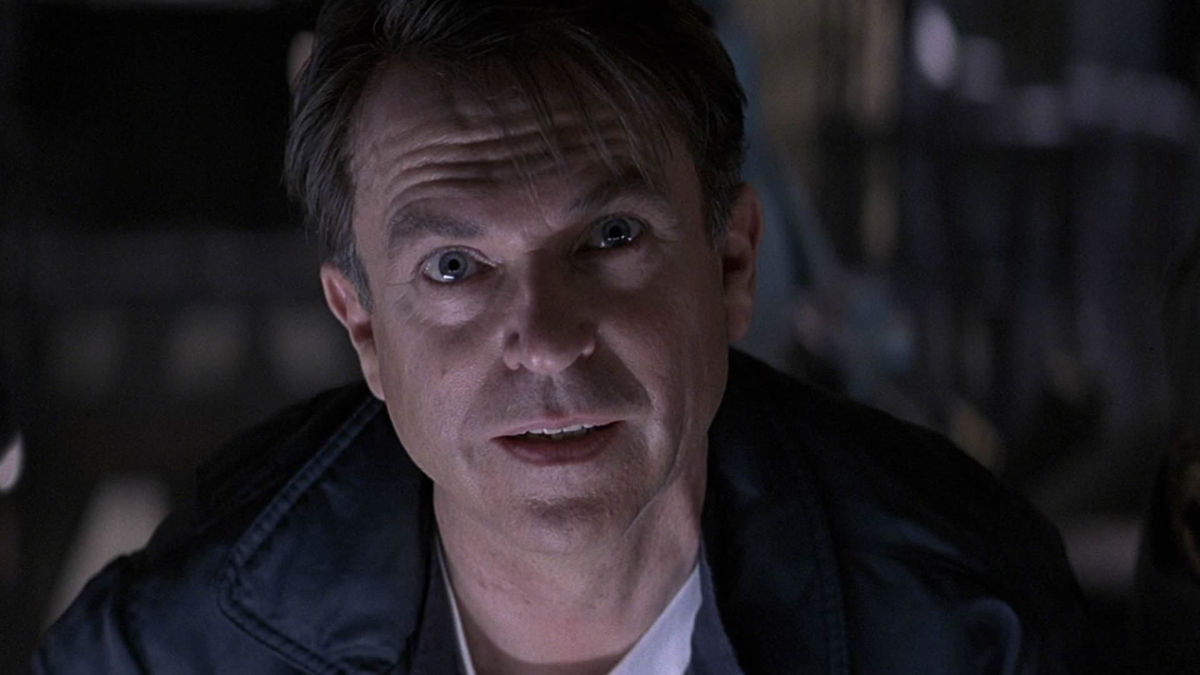
In a move one might suggest was somewhat esoteric, Paul Anderson requested the services of electronic dance music group Orbital to provide the film’s opening and closing tracks, as well as composer Michael Kamen to develop key cues throughout the movie proper. This gives the film a vague 90’s Mortal Kombat feel to its opening, which feels completely incompatible with the film itself, and yet, strangely, quite appropriate. Kamen’s more traditional film score is a solid mixture of horror themes and sci-fi grandiosity, of soaring vocal tremulousness and insidiously plucked strings – at least, that’s the evocation. The music stings often accompany plentiful and sonically jarring jump-scare moments – doors opening suddenly, shapes appearing out of nowhere, that kind of thing – and if nothing else I’ll give major props to the sound mixers for a top-tier job working with atmospherics, subtlety and bombast all in equal measure. This is a take-home surround sound mix to savour.
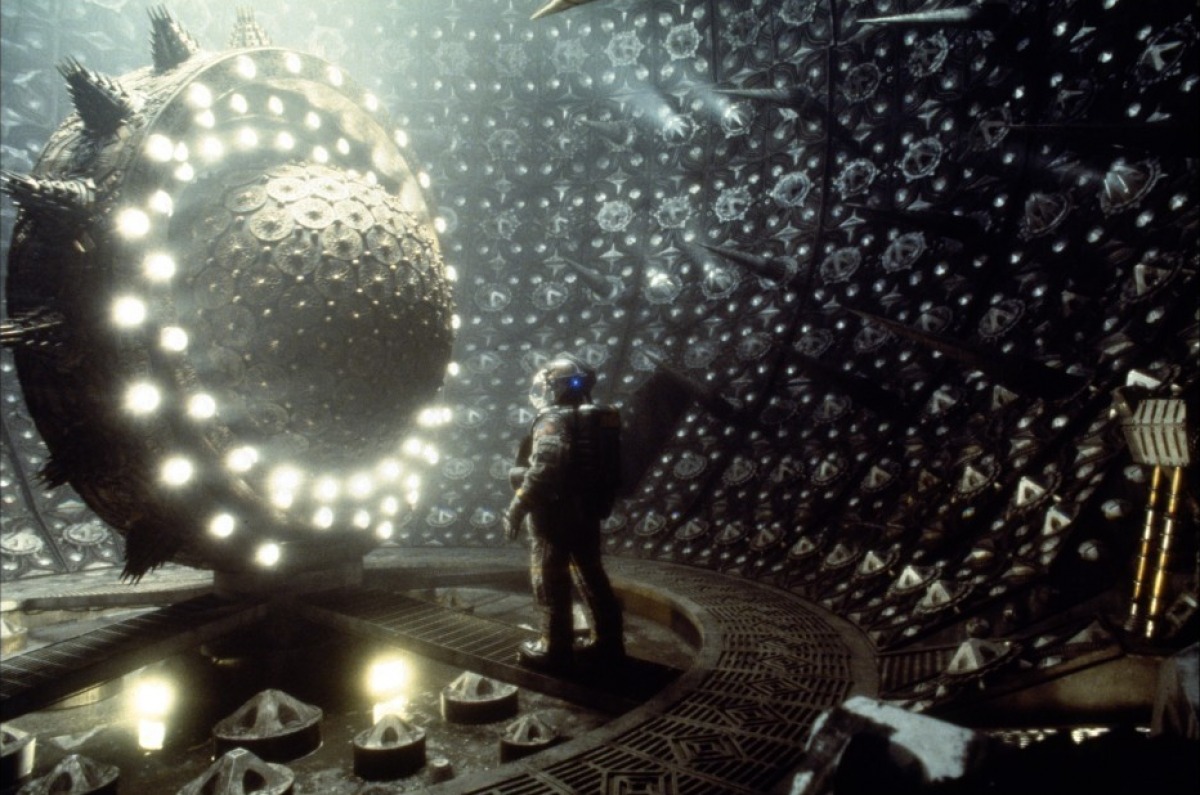
Event Horizon has often been criticised for lacking answers to the many questions its asks. This is a fault, I think, of pre-release tinkering by the studio, more than it is a problem with the screenplay, which in this truncated version of the movie never quite gets the chance to reveal itself fully. The elements of a solid horror mystery are alluded to, and a significant portion of the confronting goriness and aesthetically shocking footage indicate a broader plot device than the film eventually translated, but I think this reduction of explanation allows the audience to draw their own conclusions. Is the ship’s gravity drive really a gateway to Hell? A pathway to an alternative dimension of chaos? What is the purpose of this? The film’s final scene indicates that the end might only truly be the beginning, although at no point does the film implicitly state exactly What Is Going On for the audience to get. Perhaps this ambiguity is the cause for some people’s frustrations with the film; I know I hate unresolved issues in movies and Event Horizon has an abundance of those, but there’s something so ethereal and malignant about Event Horizon’s refusal to capitulate to genre conformity you almost admire it for its audacity. Maybe that’s giving Paul Anderson too much credit for lucking into making a minor classic genre film, I don’t know. In any case, the answers of the film lie with the viewer, not so much with the filmmaker.
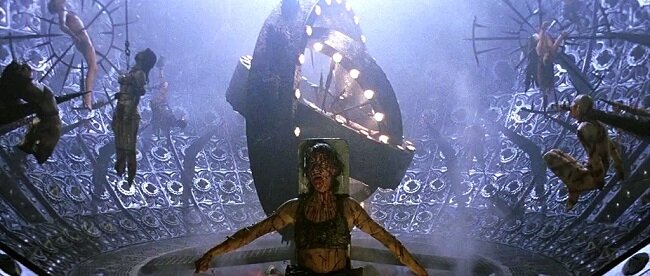
Event Horizon is a gory, scary, terrifying ride into a horror abyss. Echoes of other, usually better sci-fi and horror films abound within Event Horizon’s cataclysmic elegy to late 90’s sensibilities, although mixed together in the way Anderson manages to makes for enthralling, stylishly extravagant storytelling. The film is not without flaw, and desperately seems to need a few more things added back in to explain some of the philosophical and ethical conundrums it poses or alludes to, but as a piece of sci-fi junk horror cinema there are few movies that can match it for ferociously going for a home run despite inadequacies of the studio’s blessing. With a stellar (ha!) cast and solid production values, Event Horizon is a minor classic and holds up as a work of imaginative fiction even today.

